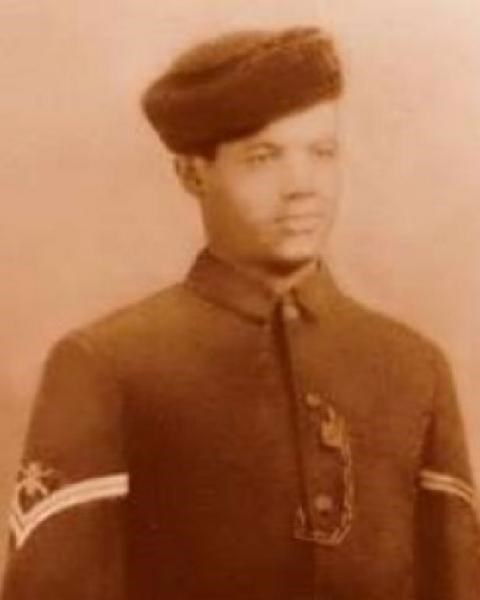Last updated: March 29, 2024
Person
William O. Wilson

Public Domain
William Othello Wilson was born on September 16, 1869, in Hagerstown, Maryland. Wilson enlisted in I Troop, Ninth U.S. Cavalry, on August 21, 1889, in Saint Paul, Minnesota. Before joining the cavalry, he was a skilled upholsterer. He quickly rose in rank to corporal.
On November 19, 1890, the Ninth U.S. Cavalry left its posts in Nebraska and Wyoming en route to the Sioux reservations to settle the nerves of the Indian Agents. The Indian Agents and White settlers in the area were panicked due to the Sioux participating in the Ghost Dance. Many whites living near the reservations regarded the Ghost Dance as a prelude to renewed American Indian militance, although it was a religious ritual that had spread among American Indian tribes throughout the West.
The Ghost Dance found many backers among the Sioux. The Ghost Dance blended traditional indigenous rituals with the expectation that a messiah would come and restore the Sioux and others to their traditional lands and former glory. To the Sioux the Ghost Dance held out hope of a return to days when they roamed at liberty and the bison were plentiful.
Ultimately more than 5,000 soldiers from several regiments converged on the Sioux reservations. While the increased soldier presence was intended to bring stability to the area, it had the opposite effect. As December unfolded, increasingly fervent ceremonies took place throughout the reservations. Groups of Sioux were leaving the reservations, heading into the hinterland to avoid Army scrutiny and control.
In late December 1890 a battalion of Ninth Cavalry Buffalo Soldiers left the Pine Ridge Agency on patrol pursuing Sioux groups that had left the reservations. The battalion was led by Major Guy V. Henry and comprised troopers from D, F, I, and K Troops. On the evening of December 29, the battalion was about 50 miles away from the Pine Ridge Agency in South Dakota. As the troopers were feeding their horses and making dinner some Army scouts entered the Buffalo Soldier camp and alerted them about the Wounded Knee Massacre that took place earlier in the day. The battalion was ordered to return immediately to Pine Ridge. Most of the battalion arrived at the Pine Ridge agency as the sun rose on December 30.
The battalion supply train was about 90 minutes behind the main battalion. Two miles from their destination the supply train was attacked by 50 Sioux warriors. At the first signs of the attack Captain John S. Loud, in charge of the supply train, circled his wagons for protection. Captain Loud knew the situation was desperate; bullets were coming from multiple directions. He scribbled a note to Major Henry asking for help.
Corporal Wilson was nearby and overheard Captain Loud asking for volunteers to deliver the message. Wilson volunteered. He mounted his horse and rode the two miles to the agency and Major Henry. Ten Sioux warriors saw Wilson leave the encircled wagons and pursued him. Wilson made it safely to the agency to raise the alarm.
Major Henry ordered the battalion to resaddle its horses after Wilson delivered the note. They rode to the rescue of their comrades and the supply train. Once the battalion arrived, the Sioux warriors retreated.
For his actions that day, Wilson received the Medal of Honor on September 17, 1891. His Medal of Honor citation simply states “bravery.” On December 17, 1891, a more detailed citation was published in General Order 100. It praised Wilson “For gallantry in carrying a message for assistance through country occupied by the enemy. When the wagon train under escort of Captain Loud was attacked by hostile Sioux Indians, near the Pine Ridge Agency, South Dakota.” Wilson was the last American soldier to receive the Medal of Honor for actions on American soil.
Two years after receiving the Medal of Honor, Wilson was stationed at Fort Duchesne near Vernal, Utah. On September 5, 1893, while traveling to Denver, Colorado, after participating in an Army marksmanship event, Wilson deserted. He made his way back to Hagerstown, Maryland. The Army never apprehend Wilson, who lived the rest of his days in Hagerstown rarely talking about his military service.
William O. Wilson died on January 18, 1928, at the age of 58. He was buried in Rose Hill Cemetery in his hometown of Hagerstown, Maryland.
